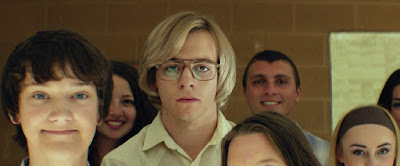Tuesday, December 26, 2017
MY FRIEND DAHMER....
How to portray the development of a serial killer? Directors usually show them being abused, or under the influence of an older, sadistic relative, but for the most part the disturbed youngster is shown staring off into space with vacant eyes, being awkward around women, perhaps torturing an animal. We sit there waiting for the moment when he realizes how liberating it can be to take someone into the woods and cut their throat.
Rarely does a film present these killers as remotely human. It only happens when a filmmaker is bold enough to suggest these murderers grew up in ways most of us will recognize. Monster (2004) had some of this, where Charlize Theron played Eileen Wuornos as a deranged highway prostitute who, when she wasn't shooting men in the head, simply wanted to be loved like anyone else. Marc Meyers' My Friend Dahmer has this, too, in that America's favorite gay cannibal is shown in a high school environment that looks more or less like an episode of Freaks and Geeks.
Dahmer's madness is difficult to understand because it can't be easily labeled. Serial killers are all superficially similar - they work out their violent fantasies by murdering over and over again - but there are enough differences between say, Dahmer and Ted Bundy and John Wayne Gacy, to keep them from being packaged together. Perhaps, like artists, serial murderers each express something unique.
Jeffrey Dahmer was one of the most baffling of serial killers. His psychosis was so personal that psychologists end up as puzzled as cartographers who have found an ancient map with unexplained landmasses near Australia. My Friend Dahmer doesn't attempt a diagnosis. It simply examines the fact that Dahmer, who raped and murdered 17 young men and preserved their bones in his Milwaukee apartment, had been a typical teenage misfit. He didn't kill because he enjoyed it, he killed because it was a means to an end. Even the usual serial killer trait of killing animals was of no interest to him; instead, he picked up roadkill and brought it home to study. How do you study the bodies of young men? They don't turn up on the road like flattened raccoons. You have to kill them.
Meyers' approach in My Friend Dahmer is very basic, but effective. He simply shows us what people do, lets us hear what they say. He is most concerned with presenting Dahmer as a kid who played trumpet in the high school band and, for a while, had some notoriety as the class clown, a boy who would get laughs by bleating like a sheep or pretending to throw epileptic fits. If you didn't know Dahmer's story, you might watch this movie and think you're seeing the origin of a punk rock singer, or a belligerent stand up comic. Sure, he brought home some dead possums, but if you heard the same about Iggy Pop you'd probably accept it as sort of weird but cool. As played by Ross Lynch, young Dahmer is shy and clumsy, trapped in a perpetual slouch, but smart enough to keep his dark side hidden.
The movie takes place inside and around the dulling middle class world of mid-seventies suburban Ohio, where Dahmer's parents play out the ritual of a failing marriage. Dahmer's mother (Anne Heche) is a pill popping, self-absorbed neurotic who has been in and out of mental health clinics, while his father ( Dallas Roberts ) is a stammering chemist who fears his son will grow up to be an unhealthy nerd. Dahmer seems oblivious to his parents, too consumed with spying on the handsome fellow next door. Dahmer even hides in the woods with a baseball bat, waiting to clobber the guy and do who knows what with him. It never happens, though. Dahmer's not yet ready for murder.
There is a sense that Dahmer understands how people are supposed to behave in society. Watch the scene where he asks a freshman girl to the prom. He's downright charming. He knows she doesn't care about him, but he convinces her to go because it will be good for her to be seen there, even with the class oddball. We can imagine him years later luring victims back to his apartment with the same logic and easy smile he used on this girl. Not all charming men are serial killers, but it's a rare serial killer who isn't charming.
Dahmer's murders were such a direct expression of his tangled psyche - a morbid interest in skeletons dovetailing with a teenager's homosexual anxieties - that one almost understands his eventual need to possess his victims utterly. He was the rare serial killer who didn't blame his actions on Satan, or pornography, or voices in his head. His overriding compulsion to know what we look like on the inside is captured in a strangely compelling scene where Dahmer and his buddies go fishing. When he's supposed to release his catch back into the pond, he kneels down and frantically hacks it apart with a knife. When he's done, he is neither excited nor satisfied. It's as if he's still searching for something, some elusive hidden treasure that exists between bones and guts.
The details of Dahmer's young life are here. The early addiction to alcohol. The isolation. The first victim, a teen hitchhiker named Steve Hicks. My Friend Dahmer is a small masterpiece mostly because Myers takes the most unlikely approach: he gives Dahmer a break, and treats him as a human. He achieves this partly by surrounding him with stuff we recognize. The kids in Dahmer's high school are familiar to me. They are types I knew, smart but not insightful. For a while, Dahmer walked among them, called a few of them friends, and made them laugh.
Subscribe to:
Post Comments (Atom)

No comments:
Post a Comment